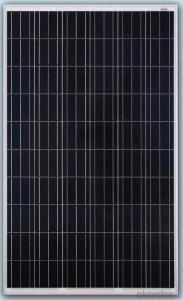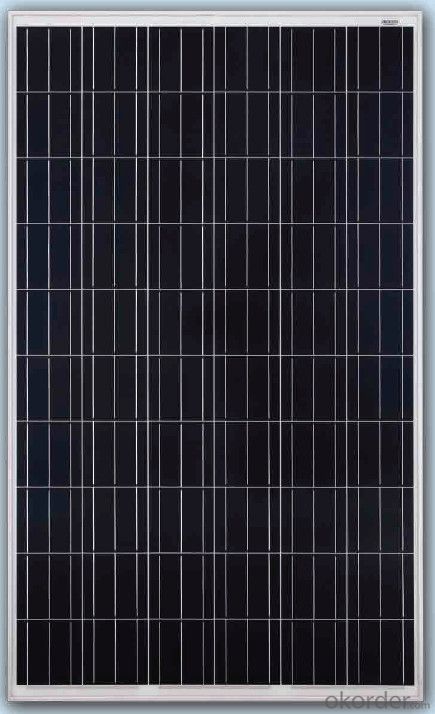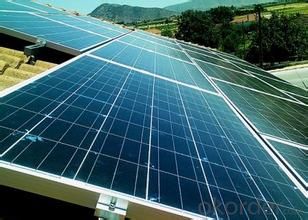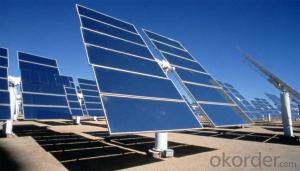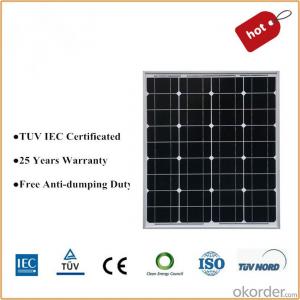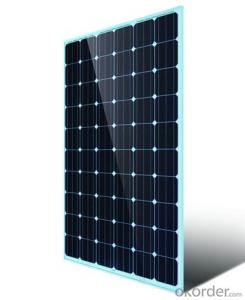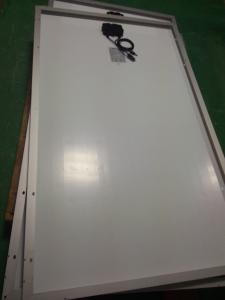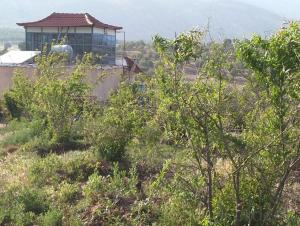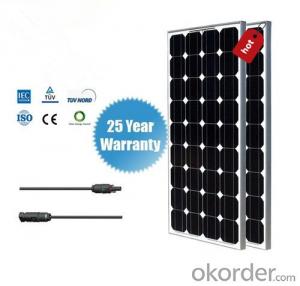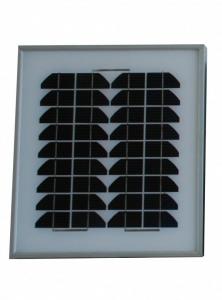Mono 80W-100W Solar Panels Roof Shingles CE/IEC/TUV/UL Certificate
- Loading Port:
- Shanghai
- Payment Terms:
- TT OR LC
- Min Order Qty:
- 1000 watt
- Supply Capability:
- 100000000 watt/month
OKorder Service Pledge
OKorder Financial Service
You Might Also Like
Quality and Safety of Poly 230W Solar Panel CE/IEC/TUV/UL Certificate
1. Rigorous quality control meets the highest international standards.
2. High-transmissivity low-iron tempered glass, strong aluminium frame.
3. Using UV-resistant silicon.
4. IS09001/14001/CE/TUV/UL
Warranties of Mono 80W-100W Solar Panel CE/IEC/TUV/UL Certificate
1. 10 years limited product warranty
2. 15 years at 90% of the minimal rated power output
3. 25 years at 80% of the minimal rated power output
Technical date of Mono 80W-100W Solar Panel CE/IEC/TUV/UL Certificate :
ITEM NO.: | Mono 125*125 cell ,36pcs . Power range from 80Wp-100Wp | ||||||||
Maximum Power(W) | 80 | 85 | 90 | 95 | 100 | ||||
Optimum Power Voltage(Vmp) | 17.81 | 17.89 | 17.94 | 17.99 | 18.06 | ||||
Optimum Operatige Current(Imp) | 4.78 | 4.91 | 5.12 | 5.35 | 5.59 | ||||
Open Circuit Voltage(Voc) | 21.98 | 22.05 | 22.14 | 22.28 | 22.45 | ||||
Short Circuit Current(Isc) | 4.95 | 5.15 | 5.36 | 5.65 | 5.84 | ||||
Solar Cell: | 125*125 Mono | ||||||||
Number of Cell(pcs) | 4*9 | ||||||||
Brand Name of Solar Cells | JA Cell, Bluesun Cell | ||||||||
Size of Module(mm) | 1580*808*35 | ||||||||
Caple & Connector Type | Pass the TUV Certificate | ||||||||
Frame(Material Corners,etc.) | Aluminium-alloy | ||||||||
Backing (Brand Type) | TPT | ||||||||
Cell Efficiency for 100W(%) | 15.8% | ||||||||
Weight Per Piece(KG) | 12.0KG | ||||||||
FF (%) | 70-76% | ||||||||
Junction Box Type | Pass the TUV Certificate | ||||||||
Tolerance Wattage(e.g.+/-5%) | ±3%, or 0-3% | ||||||||
Front Glass Thikness(mm) | 3.2 | ||||||||
Temperature Coefficients of Isc(%) | +0.04 | ||||||||
Temperature Coefficients of Voc(%) | -0.38 | ||||||||
Temperature Coefficients of Pm(%) | -0.47 | ||||||||
Temperature Coefficients of Im(%) | +0.04 | ||||||||
Temperature Coefficients of Vm(%) | -0.38 | ||||||||
Temperature Range | -40°C to +85°C | ||||||||
Surface Maximum Load Capacity | 2400Pa | ||||||||
Allowable Hail Load | 23m/s ,7.53g | ||||||||
Bypass Diode Rating(A) | 12 | ||||||||
Warranty | 90% of 10 years,80% of 25 years. | ||||||||
Standard Test Conditions | AM1.5 1000W/ 25 +/-2°C | ||||||||
Packing | carton or pallet | ||||||||
1*20' | 25 Pallets / 450pcs | ||||||||
1*40'STD | 25 Pallets / 100pcs | ||||||||
Diagram of Mono 80W-100W Solar Panel CE/IEC/TUV/UL Certificate

Standard production line of Factory
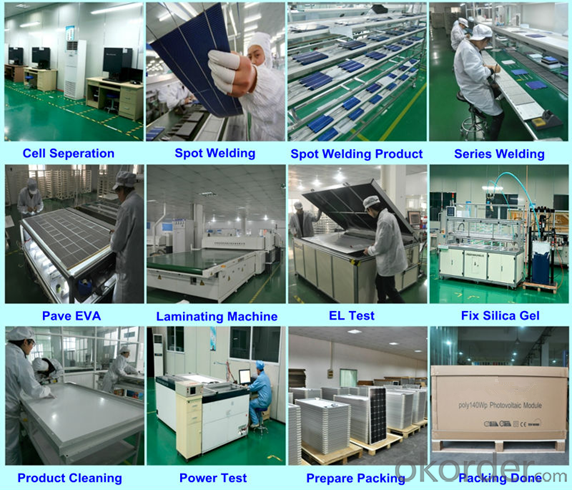
Packaging of Mono 80W-100W Solar Panel CE/IEC/TUV/UL Certificate
u Normally packing: 1pc/2pcs/3pcs/10pcs/25pcs per carton
u Individual packing requirement is acceptable.
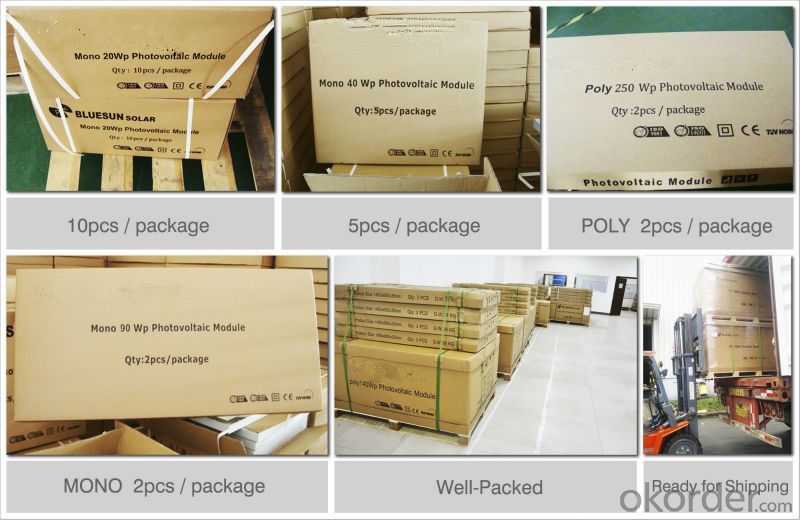
Shipping of Mono 80W-100W Solar Panel CE/IEC/TUV/UL Certificate
By Sea | Delivery from Shanghai or Ningbo seaport |
By Air | Departure from Shanghai Pudong Airport |
By Express | Post by DHL, EMS, UPS, TNT. |
FAQ of Mono 80W-100W Solar Panel CE/IEC/TUV/UL Certificate
(1) Can you offer the test report of the module?
Sure. All the solar modules must pass necessary tests including EL test and ultra-red test and other visual test of the apperance, and the test report presents all the detailed data of the modules.
(2) How to confirm about the quantity and the type of solar module?
It depends on the solar system where you want to put into use the solar modules. We have experienced engineers to design for your order and you need to give more information to fix the details.
- Q: if i have a 0 Watt solar panel what does that mean. does that mean it will charge a battery 0 watts per hour? Lets say i hook this up to a car battery and use the car battery to run computer stuff. How much will this charge the battery?
- Watts okorder /
- Q: I'm trying to charge rechargeable AA batteries with a solar panel. What guage wire should I use to connect the panel to the batteries? Should I use a diode to keep the batteries from overpowering the circuit? If so, what size? My panel is 4.8V 50mA.
- You not only need a diode, but a circuit that opens the circuit if the voltage falls below a certain level. The diode is not the problem, but the batteries powering the solar panel when the voltage falls to low.
- Q: the solar panel works with LEDs, small bulbs,etc but neve with any dcmotor. Please help. I have a science exhibition.
- It may well be that the motor demands more *current* than the panel can provide. Can you measure the voltage from the panel with the LEDs across it, and then with the motor across it? I suspect that you'll find that the motor makes the voltage collapse.
- Q: Can solar panels be used for powering traffic lights?
- Yes, solar panels can be used to power traffic lights. Solar panels convert sunlight into electricity, which can be used to power various devices, including traffic lights. This renewable energy source can provide a sustainable and reliable power supply for traffic lights, reducing dependence on traditional electricity sources.
- Q: Can solar panels be used in areas with limited sunlight?
- Yes, solar panels can still be used in areas with limited sunlight. While solar panels are most efficient in direct sunlight, they can still generate electricity even in areas with less sunlight. The panels can capture diffuse sunlight and convert it into usable energy. However, the overall energy output may be lower compared to areas with abundant sunlight. Additionally, advancements in solar technology and the use of more efficient panels can further enhance their performance in areas with limited sunlight.
- Q: How much energy can solar panels generate?
- The amount of energy that solar panels can generate depends on various factors such as the size and efficiency of the panels, the location and climate conditions, and the amount of sunlight available. In general, a typical solar panel can produce around 250 to 400 watts of power per hour under optimal conditions. However, the overall energy output can vary significantly, and larger solar installations can generate much higher amounts of electricity.
- Q: A homeowner is considering putting a horizontal solar panel on her roof to heat water for domestic use. An average increase of water temperature each day from 60oF to 20oF is wanted for 50 gallons. How large a panel would be needed on a clear winter day at 40o latitude if the overall efficiency is 50%?
- Solar okorder
- Q: Polycrystalline solar panels are good or single crystal solar energy is good
- . Since monocrystalline silicon is typically coated with tempered glass and waterproof resin, it is rugged and durable for up to 15 years and up to 25 years.
- Q: Can solar panels be used in areas with high levels of electromagnetic interference?
- Yes, solar panels can be used in areas with high levels of electromagnetic interference. However, it is important to ensure proper installation and grounding of the solar panels to minimize any potential impact on their performance. Additionally, the use of appropriate shielding and surge protection devices can help mitigate the effects of electromagnetic interference on solar panel systems.
- Q: how to make electricty using solar panels or wind generator
- Hey Bandit, there are some really good websites on the subject, my favorites are operated by non profit groups, I will list them below. As the old saying goes, the best things in life are free, but there is one really good exception to that rule. Home Power Magazine is the only periodical that gets into the nuts and bolts of home grown energy. We started reading it 2 years ago. A couple years after that we attended an energy fair that was listed in the magazine, ended up buying our first solar panel and wind turbine on the spot, and hooking up a small 2 volt power system for our home that year. It worked really well, we did make some mistakes, but with the knowledge and experience we gained, we were able to get into a larger system a few years later. Now our home generates almost all its own power, and we use the utility company for backup. There is a .4 kw solar array on the garage roof, and a kw turbine on a metal tower in the field behind the house. We have also installed a batch solar water preheater and have 2 wood stoves for heat. Now our electric bills are around $6 per month. If your handy at all hooking up electrical devices, you could put together a small system like we did years ago and use it to run some small 2 volt lights and electronics. We still have our little system today, it operates the cabinet lighting in the kitchen, a few radios and phone answering machine, and we have 2 volt outlets in each room. They're handy for stuff like charging your cell phone with a car cord. I would suggest looking at the websites first, and if you're really interested, go for a one year subscription to Home Power. If you subscribe, you can even use their website to look at archived articles from years past. There is even one on our small system, the magazine liked the idea so much they wrote it up. Use their search engine to look for, Small System First. Hope you find all this interesting. Take care Bandit, Rudydoo
Send your message to us
Mono 80W-100W Solar Panels Roof Shingles CE/IEC/TUV/UL Certificate
- Loading Port:
- Shanghai
- Payment Terms:
- TT OR LC
- Min Order Qty:
- 1000 watt
- Supply Capability:
- 100000000 watt/month
OKorder Service Pledge
OKorder Financial Service
Similar products
Hot products
Hot Searches
Related keywords
